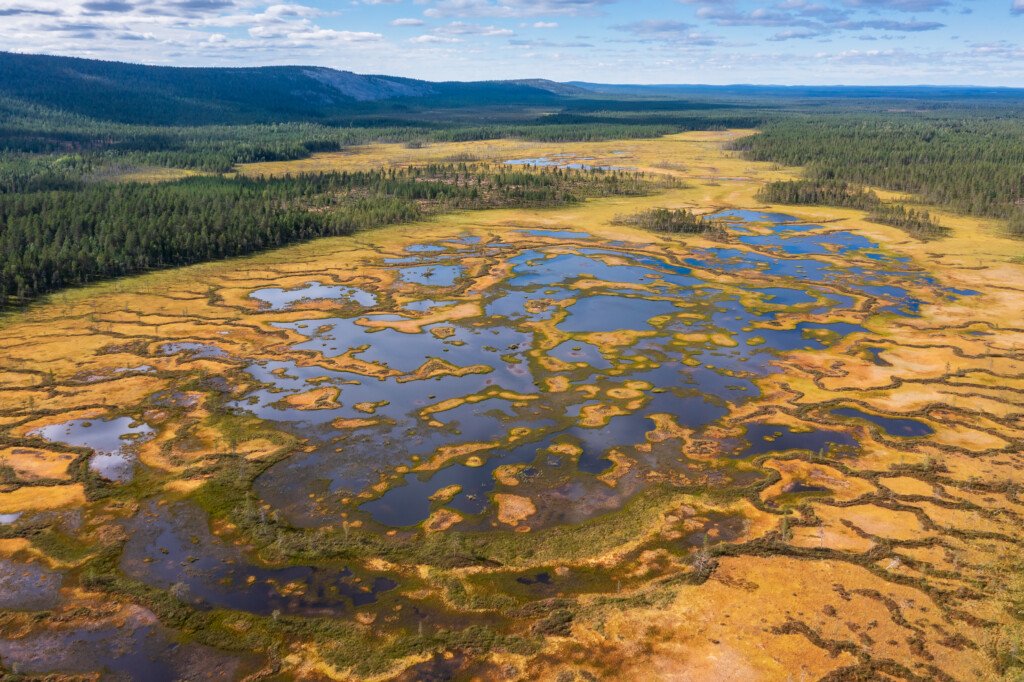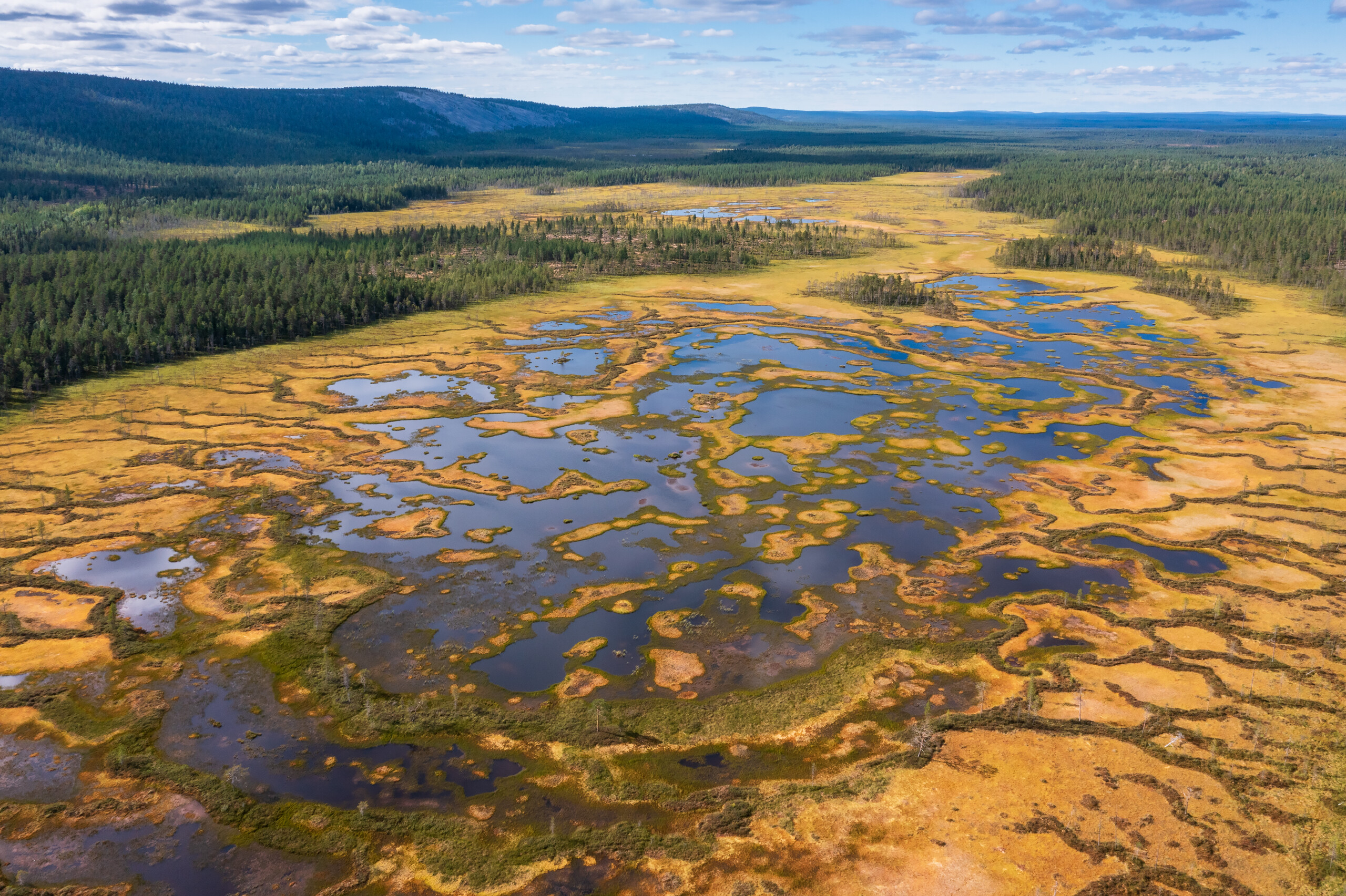LINKED PAPER Disappearing aapa mires and why we should care: unnoticed climate change exacerbates drainage effects on birds. Fox, A.D., Lehikoinen, A. 2025. IBIS. DOI: 10.1111/ibi.13385 VIEW
Aapa mires are the most extraordinary of northern sub-arctic landforms. Seen from the air above, many appear more water than solid ground (Figure 1), but they are very distinctive nutrient-enriched peatlands, characterized by large stretches of open water (so-call flark-strings) crisscrossed by thin slivers of retaining peat walls strengthened by distinctive vegetation. Aapa mires are quite unlike their related peatland landforms, the raised bogs and palsa mires, yet all of which form distinctive, important and diverse natural wetlands that intersperse the taiga forest zone of Eurasia. The distinct open water flarks of aapa mires support a highly specialized community of breeding migratory waterbirds, including Broad-billed Sandpiper Calidris falcinellus, Jack Snipe Lymnocryptes minimus, Taiga Bean Goose Anser fabalis and Pintail Anas acuta as well as supporting high densities of other nesting wader species (Wood Sandpiper Tringa glareola, Spotted Redshank Tringa erythropus, Ruff Calidris pugnax, Common Snipe Gallinago gallinago, Curlew Numenius arquata and Whimbrel Numenius phaeopus) compared to other peatland landforms.

Figure 1. Joutsenenpesäaapa string bog in Sodankylä, Lapland, Finland © Simo Räsänen.
Despite the fact that we like to think of the taiga forest as a natural wilderness, in places like Finland, where aapa mires are particularly abundant, research has confirmed rapid and massive loss of aapa mires through drainage in recent decades. Clearly, the loss and degradation of such unique habitats from ditching and drying has immediate consequences for the bird species depending upon them, but now, recent remote sensing, palynology, peat stratigraphy and botanical studies also confirm that recent climate warming and increased precipitation has caused, and is causing, the expansion of acidic raised mire vegetation which is engulfing aapa mires, destroying their unique surface and nutrient characteristics. Ironically, climate change is favouring the growth of Sphagnum moss, which grabs scarce nutrients from its environment in exchange for hydrogen ions which turns the groundwater and substrate increasingly acid. These conditions inhibit the fungal and bacterial breakdown of dead plant matter and lead to the accumulation of acidic peat, which builds up increasing isolating the peatland from the nutrient rich waters that characterise aapa mires and keep their string flarks as open water. Raised bogs are, of course, hugely important in their own right, not least being vital sites of carbon sequestration, as well as supporting their own unique flora and fauna. However, when drainage now exacerbated by climate change combine to result in the overgrowth of aapa mires by raised mire, it is obvious that the unique avian species associated with aapa mires are about to become much scarcer as their habitat disappears. This is especially true for the Broad-billed Sandpiper, which depends on the flarks systems for nesting habitat (and was recently red-listed by BirdLife international) and the Taiga Bean Goose, which depends on the string pool complexes in July for brood-rearing habitat, because of the abundance of gosling food plants there, including Rannoch-rush Scheuchzeria palustris, Bogbean Menyanthes trifoliata and various sedge species Carex spp..
This sounds like yet another gloomy combination of factors leading to the degradation of a vital habitat far away out of sight, about which we can do little. However, the reality is far from the case. Aapa mires are classified as habitats of prime importance under the European Union Habitats Directive and Finland lies in the middle of European distribution of aapa mires in the region. While the effective conservation of aapa mires for the future in the face of climate change is undoubtedly challenging, it is by no means insurmountable. We need to instigate a coordinated international site safeguard programme that protects the remaining resource, prioritising the extent, physiography, quality, flora and fauna of key sites. It is vital to initiate manipulative studies to determine whether hydrological management can inhibit the shift from aapa to raised mire vegetation to restore lost habitats. The widescale restoration of damaged, drained and degraded aapa mires needs to be instigated and the ability of different rewetting and hydrological management techniques to restore their key physiographical, floral and faunal features monitored to ensure best practice. International interdisciplinary collaboration through partnerships across conservation organisations, research institutions and the responsible government agencies (perhaps under supranational bodies such as the European Commission, Ramsar Convention or the African Eurasian Waterbird Agreement) needs to be strengthened to provide a framework for collaborative actions to conserve aapa mires. We really owe it to coming generations to protect and pass on this unique landform and habitat and the range of species (including specialist migratory birds) that seasonally depend upon this disappearing and currently degraded resource. More than that, the case of the threats to aapa mires also highlights the need to establish new mechanisms to create cohesive networks of protected areas for special habitats that are of disproportional importance to key, or aggregations of, critical avian and other species, that may not be adequately represented within current site-safeguard networks.





